Another publication milestone I thought I’d advertise on my blog:
Sometime over the summer a German publishing house contacted me about publishing my dissertation. Not a rewrite in the American style, but quite simply the dissertation itself, with a cover of choice and my photo on the back cover (groan!!!) and permission to reprint up to 20% of it verbatim in papers; all at no cost to me. Since the first paper was already published, a second spinoff underway and a possible third spinoff in the wings, I figured that the traditional diss-to-book publication wasn’t a happening option. The book I have in mind for that project is altogether different, and so I gratefully accepted their offer and uploaded the book. Several weeks later, it popped up on Amazon.
Check it out:

It’s really exorbidantly priced so I wouldn’t advice anyone to buy a personal copy but anyone with a library or academic allowance for such things, please do your friend a good turn. Apparently I stand to get a minimal royalty for every copy purchased.
Rosetta is actually the Frenchification (and possibly further Anglicization) of Rashid, which is the name of the town near the mouth of the Nile some 65 km outside Alex, where the French found the Rosetta stone, while attempting to restore the old Qaitbey fort there. Amid the foundations was this stone with inscriptions in three scripts, consequently providing the key to deciphering the hieroglyphics of the ancient Egyptians, or at least the Ptolemaic Egyptians.
Now I’ve seen the Rosetta stone – I did so 2003 at the British Museum, though at the time it was the sarcophagi and the smaller artifacts that fascinated me and so I did not spend hours gazing at it as I might now. I have also viewed it’s life-size replicas at the Egyptian museum and now at the Qaitbey fort. The image is familiar to most, I believe; a black surface with the now famous three bars of different scripts the decoding of which led to a race between the French and English, eventually won by Champollion. All that’s a well known story. A little less well-known perhaps is the question of how, when the French both discovered it and deciphered it first, it got into the grubby hands of the Brits. And as was usual with most French mishaps of the time, it was Napoleon Bonparte’s fault. First he abandoned his armies and his savants in Egypt to return to fight in France, and then he had to go get defeated there. Meanwhile, the Frenchies back here roundly routed as they were with ships destroyed and no way to get home, cut a deal with the British. In return for taking them back to France in their ships, the Brits took possession of all their archeological finds. Including this stone.
But the stone continues to provide us with stories. For many years now the stone was believed to be naturally black – the legend beside the replica at Qaitbey informs us that it was a stone made of of black basalt – but apparently people harbored an erroneous impression. After a cleaning project about a decade ago, what emerged was a shade of pink. Evidently the travel and London Grime (deposited perhaps by waves of London Fog?) had covered the underlying stone so such an extent that it looked jet black. The stone turned out to be, by some strange coincidence, Rose granite. It’s very likely that it was the cleaned version of the stone I saw at the British Museum, but like I said I paid less attention to this piece than I should have then.
As for its original purpose? It was apparently a stone decree sent out by Egyptian priests during the reign of the Ptolemies exhorting the virtues of the Ptolemaic kings, as a way of showing their loyalty to the ruler (and currying his favor too no doubt). Such cannibalized pieces of the ancient world frequently turn up in later structures – you may remember my mentioning the use of Roman columns to fortify the crusader castles (in Byblos). And of course the white limestone layer over the Giza pyramids have been systematically eroded except for the tip of the second. Rome is full of churches made with the loot from the temples of the Romans of yore. And so it goes…
Before heading to the Qaitbey fort in Rashid, John took us on a walking tour of the town to show us a very interesting examples of some late 18th/early 19th century architecture and architectural decoration of painted bricks, which as I understand is singular in this town within Egypt (Yemen is where a lot of this type of decoration . Small as the town is, its governing body decided to divert considerable funds into restoring various buildings – private homes, mosques, a public bath – to their original state, and hence a walk through its streets is a visual treat. Muddy as the small streets were due to recent rains – it rains often and hard in these areas – the town was mostly clean, and the people (perhaps lulled by the holidays) did not accost us with outrageous comments or offers. And the red and black -painted brick facades were really beautiful. We visited a bath house and witnessed some strange acoustic tricks in the main bath area as well.
Click for some picks:
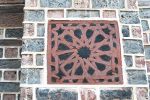
After our walk, and a visit to the fort, we drove out to the point where the river flows into the sea, i.e. the mouth of the Nile. Out there we say some fishing boats bobbing up and down, haplessly it seemed, amid the opposing currents of river and sea, but those folks seemed to be holding their own. Their work inspired us to go searching for fresh fish of our own, only ours required less adventurous methods. We simply went to a restaurant.
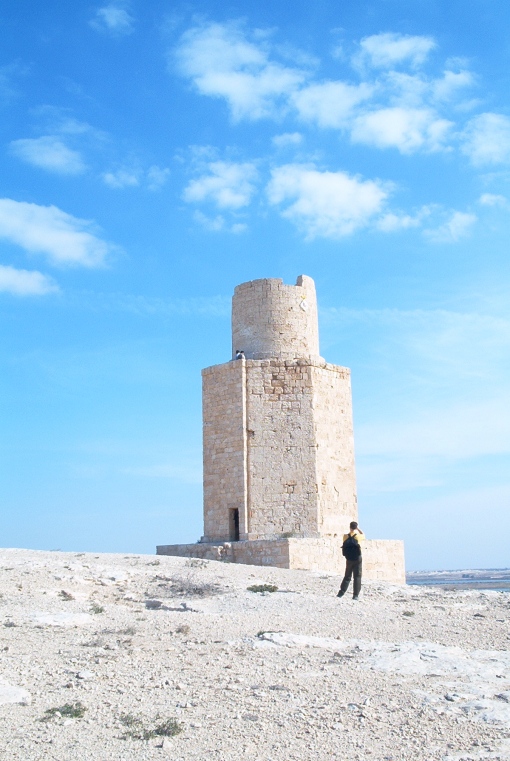
I just got back from a trip to Alexandria, adding yet another notch to my Egyptian Tourism belt. This post is by no means a detailed account of the trip (which may be consigned to the backblog category) but just one piece of it – the lighthouses.
I’ve always had a fascination for lighthouses, and still harbor the lurking dream of my childhood to live in one by a choppy coast (in Cornwall, Maine, British Columbia??). Which might be the reason that along with the Pyramids of Egypt and the Hanging Gardens of Babylon, the Lighthouse of Alexandria are the three of the seven wonders of the ancient (classical) world that I never forget in my enumeration. But what I knew about the lighthouse, or rather what I thought I knew, turned out to be just a small detail of a far more fascinating story than I had imagined! Although, why I should be surprised at this turn of events, after a year and half under the aegis of John Swanson, I cannot fathom. I should be used to such revelations by now…
Anyway, the basic details of the Alexandrian Lighthouse or the Pharos – not to be confused with Pharaohs, another subject of Egyptian legends, but whose phonetic similarity to the towers of lights is likely pure coincidence – is the stuff of legend embellished upon the facts which are pretty amazing on their own. 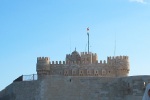 Built by the Ptolemies in the 3rd century B.C., the Pharos stood at the tip of a peninsula in Alex and served (as all lighthouses are supposed to) as a marker to guide the ships to safe harbor. It was a huge edifice, rivaled only by the much older, great Pyramids in height, measuring over 100 meters in height. Drawings and descriptions tell us that it has a three-part structure – a broad octagonal base, whose dimensions correspond closely to the outer walls of the 15th century fort Qait Bey that now occupies the site; a very tall cylindrical part that gave the tower its height and housed the staircase leading up to the top; and a cupola like structure which gave the lighthouse its light, in the form of a large fire, which was magnified with mirrors.
Built by the Ptolemies in the 3rd century B.C., the Pharos stood at the tip of a peninsula in Alex and served (as all lighthouses are supposed to) as a marker to guide the ships to safe harbor. It was a huge edifice, rivaled only by the much older, great Pyramids in height, measuring over 100 meters in height. Drawings and descriptions tell us that it has a three-part structure – a broad octagonal base, whose dimensions correspond closely to the outer walls of the 15th century fort Qait Bey that now occupies the site; a very tall cylindrical part that gave the tower its height and housed the staircase leading up to the top; and a cupola like structure which gave the lighthouse its light, in the form of a large fire, which was magnified with mirrors.
Garbled stories about it and the library (subject for a separate post) had created this vague impression in my head that it has been set fire to and demolished in antiquity, but in fact the lighthouse survived into the middle ages, and was a fully functional structure until the 14th century or so when a particularly violent earthquake caused it to topple into the sea, where pieces of it still reside, while other pieces [ massive boulder-sized pieces] have been dredged up and can be seen in an open air museum at the Kom-el-dikka site.
What turned out to be the most amazing thing to me, was that this great Pharos, was not the only lighthouse in antiquity, though it was certainly the tallest and most important by far, as well as the only one to have actually stood by the sea. 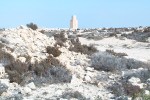 It seems to have belonged to an entire chain or system of lighthouses built by the Ptolemies along the north coast of Egypt east of Alexandria, which was its main port, to help guide ships being blown in westward by the winds from Greece, Cyprus, Turkey etc. The sole surviving structure from this chain is a lighthouse at ta place now known as Burg al-Arab some 20 km east of Alex. It stands overlooking another monument from the period, the ruins of a temple dedicated to Osiris, one corner of which is according to popular myth a possible burial place of Cleopatra.These lighthouses were basically similar to the great Pharos in structure, but stood only about a third of its height (about 30-35 meters cupola inclusive) atop a limestone ridge that runs a few kilometers, if that from the coast. Imagine the solace this series of fires must have offered to the sailors, a sign that land was near, and a preparation for the stunning sight of the great tower ahead!
It seems to have belonged to an entire chain or system of lighthouses built by the Ptolemies along the north coast of Egypt east of Alexandria, which was its main port, to help guide ships being blown in westward by the winds from Greece, Cyprus, Turkey etc. The sole surviving structure from this chain is a lighthouse at ta place now known as Burg al-Arab some 20 km east of Alex. It stands overlooking another monument from the period, the ruins of a temple dedicated to Osiris, one corner of which is according to popular myth a possible burial place of Cleopatra.These lighthouses were basically similar to the great Pharos in structure, but stood only about a third of its height (about 30-35 meters cupola inclusive) atop a limestone ridge that runs a few kilometers, if that from the coast. Imagine the solace this series of fires must have offered to the sailors, a sign that land was near, and a preparation for the stunning sight of the great tower ahead!
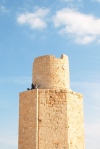 What survives today is the octagonal base and a stump of the cylindrical tower of the lighthouse. Its possible to climb to the top of the octagonal base via a frighteningly rickety wooden staircase – which I’m sure is a modern day contraption to replace the disintegrated original, which was probably brick or stone – covered with sand that zigzags its way up the shaft of the tower. The photographic proof of the courage of our party, and though the faces are too small to pick up with my zoom, I assure you that the little ones August and William are up there, along with their truly courageous Mom, who had both them and their nearly-born baby brother in tow. They had already decended, before I even started on my way up – just as well, for you do not want to share this confined spaces here. If you brave those stairs [ Missed photo opportunity] then certainly do not miss going up the stone stairs in the cylindrical part to reach the current top. I did it and let me assure you it was a lot less scary than the wooden stairwell! More Alexandrian trivia on the next post…
What survives today is the octagonal base and a stump of the cylindrical tower of the lighthouse. Its possible to climb to the top of the octagonal base via a frighteningly rickety wooden staircase – which I’m sure is a modern day contraption to replace the disintegrated original, which was probably brick or stone – covered with sand that zigzags its way up the shaft of the tower. The photographic proof of the courage of our party, and though the faces are too small to pick up with my zoom, I assure you that the little ones August and William are up there, along with their truly courageous Mom, who had both them and their nearly-born baby brother in tow. They had already decended, before I even started on my way up – just as well, for you do not want to share this confined spaces here. If you brave those stairs [ Missed photo opportunity] then certainly do not miss going up the stone stairs in the cylindrical part to reach the current top. I did it and let me assure you it was a lot less scary than the wooden stairwell! More Alexandrian trivia on the next post…
A sudden impulse to see a friend, a couple of phone calls and emails exchanged, and there I was, off in a plane to Geneva over the Thanksgiving weekend. Just like that. And within four hours I was in a different world.
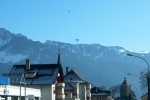 And what a very cute and kitsch world I went to! Although Europe does not have the equivalent of the American thanksgiving holiday, it too starts to decorate itself for Christmas around the last weekend in November. Everywhere I went, booths were going up for the local Weinachts Markts (the Christmas markets) in the center of town, vendors were selling hot roasted chestnuts (marroni) and the streets were decorated with lights etc, shops with all the traditional symbols etc. And the weather matched the season — it was chilly , the landscape was dotted with snow, and walking around in my bright red wool coat, I felt like I was in a snow globe. All one had to do was shake.
And what a very cute and kitsch world I went to! Although Europe does not have the equivalent of the American thanksgiving holiday, it too starts to decorate itself for Christmas around the last weekend in November. Everywhere I went, booths were going up for the local Weinachts Markts (the Christmas markets) in the center of town, vendors were selling hot roasted chestnuts (marroni) and the streets were decorated with lights etc, shops with all the traditional symbols etc. And the weather matched the season — it was chilly , the landscape was dotted with snow, and walking around in my bright red wool coat, I felt like I was in a snow globe. All one had to do was shake.
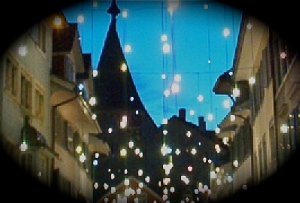
Christmas lights up in Old Zurich
I flew into Geneva, a town I’d never visited before, and still don’t count as having visited since I did little else there but fly in and out as it is the only Swiss city that EgyptAir flies to. Sanja, bless her heart, had scheduled her meeting there on the day of my arrival, which meant that I got a ride back to her town rather than having to ride the 2 hour train by myself. It is actually a gorgeous ride via Lausanne with a long stretch alongside (as I found out on my return on Monday morning), but it was even more fun to spend the time with Sanja. We had dinner in a little restaurant in her new hometown of Murten aka Morat, a tiny village on the cusp of French and German Switzerland with 3 or so streets within its medieval (well, they looked medieval) walls.
Thursday I explored the town while Sanja went to work, which meant, I wandered for about half-an-hour trying to access the wall, looking down to the lake and then settling for a classic Swiss hot chocolate (yum!) a cheese pastry and strawberries with fresh cream at a charming little cafe in town. As I said before, everything the very embodiment of kitsch, what with large X-mas candle like lights dotting the various buildings in town. It was a foggy day and there was not much opportunity for pictures. Night saw us at a little French restaurant in Bern, where a black truffle topped flatbread sent me into swoons of delighted gratitude to all the powers that might be. For the record, the rest of the dinner wasn’t too shabby either but the first bite was the highlight.
The next day I took a train bright and early (relatively so anyhow) to St. Gallen, which is clear across the country (the Northeast corner) nearly at the Austrian border. The main purpose of this trip was to see Jochen, an old friend (actually he’s quite young having only just turned 30 a few weeks ago) from Heidelberg/Yale days. While it’s at the opposite end of the country, St. Gallen too offered more than its fair share of Swiss kitsch, beginning with the fabulous fondue lunch in the heart of town and ending with my lovely sleeping quarters in Jochen’s attic apartment – by a damped down fireplace under sloping roofs where each window nook formed a natural refrigerator (a good and necessary thing, as I will explain shortly). Between these two landmarks, I visited St. Gallen’s monastery which has a reknowned library (the Spitzbibliotek) with rare old books dating to the 14th century at least, if not earlier. It is in fact one of the few libraries that has survived unscathed from the Middle Ages, and would have been a remarkable treat had it not been for the unfortunate fact of its being closed for renovations. I did get to see the underground Lapidarium however, with its marvelous collection of colored keystones, as well as a fine exhibit on bookmaking. After which I took a funicular up the mountain and went for a walk along a ridge which gave me a nice overview of the town or at least, would have had the day been clearer.
Jochen is very much part of that phase of my life when my culinary adventures were proceeding at full throttle, and he was one of my two German “adoptees” as Bidjan (the other one) put it. Since then any meeting has been an excuse for an evening of cooking and eating and this time was no different. The final headcount for the evening was that magic number 7, which included Andreas, another Yale connection who actually drove down all the way from Zurich to St. Gallen, but then turned right back and drove back the same night rather than stay the night. The other four were local friends of Jochen – and a real pleasure to meet. Dinner was an elaborate affair of Indian food, or rather, Indian-inspired food based on available ingredients, which was just about everything. The menu included the following:
Chicken liver katthi roll appetizer.
Rice – we kept it basic and simple. But it had to be Basmati rice.
Tamarind Chicken curry. Flavored with lots of curry leaves (which we found by the bagful at the Indian store), and garam masala spices ground then and there.
Fried Okra sabzi
Spinach daal (first recipe on page) using yellow split peas
South Indian Podimaas-style potatoes. i.e. mashed lightly and seasoned with mustard seeds, fresh ginger, green chillies, plenty of friend cashews and fresh cilantro (coriander leaves)
Yogurt for the tender-tongued or thirsty amongst us
Tomato chutney (variation of first recipe with garlic, ginger and lots of chillies)
Dessert: Dried figs stewed in a cheap Gluhwein with cinnamon and cloves and served with a mascarpone/creme fraiche whip.
(For readers wanting recipes, please be patient, I’ll post those on my food blog by and by, and provide links to them from here when I do).Though the food diminished in quantity with gratifying speed, the Swiss refrigerators were still too small to accomodate the leftovers, which is why the aforementioned window niches came in handy. With outside temperatures falling to -9 Celsius or thereabouts, these nooks formed natural refrigerators, at least for the night.
 Saturday morning was a sleep-in sort of morning, a natural consequence of our late-night revels which had only ended at 3 in the morning. Plus the toasty bed next to the fireplace and a dead phone conspired to keep in bed till about oh…. Suffice it to say that the sun, which cooperated with my holiday plans and shone nice and bright that morning was well past peeping into the windows, by the time any of us had stirred. Coffee, breakfast and a chat later I was on a train to Zurich, where I met up with Sanja and wandered around the streets of the old part of the city. Days are noticeably shorter, on the other side of the Mediterranean Sea right now, and once it gets dark it gets really cold, so we headed indoors once dusk set in. A ride up to a bar called Jules Verne, housed in what was once an observatory, proved too crowded and smoky, and so we came back down and settled down to a marvelous tapas dinner at the Urania hotel at the base. One taste of a seared piece of foie de canard – marinated in a Porto and served on buttered toast, made everlasting fans of both of us and we got a second helping of the same. Washed down with a dry sherry (I decided to stick to a Spanish theme) with almost salty undertones (reflective of some aging near the sea, I’m guessing) this was a snack worth immortalizing.
Saturday morning was a sleep-in sort of morning, a natural consequence of our late-night revels which had only ended at 3 in the morning. Plus the toasty bed next to the fireplace and a dead phone conspired to keep in bed till about oh…. Suffice it to say that the sun, which cooperated with my holiday plans and shone nice and bright that morning was well past peeping into the windows, by the time any of us had stirred. Coffee, breakfast and a chat later I was on a train to Zurich, where I met up with Sanja and wandered around the streets of the old part of the city. Days are noticeably shorter, on the other side of the Mediterranean Sea right now, and once it gets dark it gets really cold, so we headed indoors once dusk set in. A ride up to a bar called Jules Verne, housed in what was once an observatory, proved too crowded and smoky, and so we came back down and settled down to a marvelous tapas dinner at the Urania hotel at the base. One taste of a seared piece of foie de canard – marinated in a Porto and served on buttered toast, made everlasting fans of both of us and we got a second helping of the same. Washed down with a dry sherry (I decided to stick to a Spanish theme) with almost salty undertones (reflective of some aging near the sea, I’m guessing) this was a snack worth immortalizing.
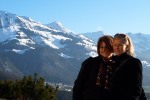 Sunday, my last full day in Switzerland. Joined by Gabi, a long-time connection through Sanja, we drove down to the village of Gruyere, whose kitsch factor surpassed all the others. A cobble-stoned village set upon a hill complete with a turret-bearing castle that houses a museum, which, not wanting to waste either time or sunshine, I opted out of visiting this time. Besides its famed cheese, a must-have ingredient for most fondues, Gruyere also boasts a spectacularly rich double cream that without any help from whisks or whips has the consistency of ice-cream. I got my taste of this cream was with fresh raspberries as my dessert, which followed a lunch of the “other” must-have cheese experience when in Switzerland, Raclettes. Truly a town to clog your right main is Gruyere… but what the heck, at least one dies happy.
Sunday, my last full day in Switzerland. Joined by Gabi, a long-time connection through Sanja, we drove down to the village of Gruyere, whose kitsch factor surpassed all the others. A cobble-stoned village set upon a hill complete with a turret-bearing castle that houses a museum, which, not wanting to waste either time or sunshine, I opted out of visiting this time. Besides its famed cheese, a must-have ingredient for most fondues, Gruyere also boasts a spectacularly rich double cream that without any help from whisks or whips has the consistency of ice-cream. I got my taste of this cream was with fresh raspberries as my dessert, which followed a lunch of the “other” must-have cheese experience when in Switzerland, Raclettes. Truly a town to clog your right main is Gruyere… but what the heck, at least one dies happy.
Gruyere is also the town that the set designer of the Alien movies hails from, and he brought his peculiar vision back home to roost in the form of a rather bizarrely done-up cafe/bar. Behold some pictures:
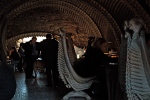
Alien pleasures in Gruyere
But really, these are not the images I want to leave as a last impression of my visit to this beautiful country, which Sanja got me into the habit of calling “Heidi-land.” The pictures of the mountains and landscapes are much pleasanter, and on the whole, form a more fitting impression of hills that come alive with music (Yes we did indeed sing that song) and whose snowy heights are unreachable but to a small group of intrepid types. Me, I was content to admire the peaks from a distance!
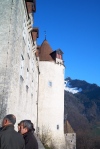
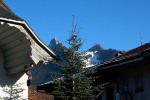
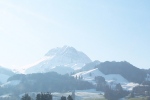
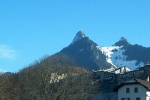



 Built by the Ptolemies in the 3rd century B.C., the Pharos stood at the tip of a peninsula in Alex and served (as all lighthouses are supposed to) as a marker to guide the ships to safe harbor. It was a huge edifice, rivaled only by the much older, great Pyramids in height, measuring over 100 meters in height. Drawings and descriptions tell us that it has a three-part structure – a broad octagonal base, whose dimensions correspond closely to the outer walls of the 15th century fort Qait Bey that now occupies the site; a very tall cylindrical part that gave the tower its height and housed the staircase leading up to the top; and a cupola like structure which gave the lighthouse its light, in the form of a large fire, which was magnified with mirrors.
Built by the Ptolemies in the 3rd century B.C., the Pharos stood at the tip of a peninsula in Alex and served (as all lighthouses are supposed to) as a marker to guide the ships to safe harbor. It was a huge edifice, rivaled only by the much older, great Pyramids in height, measuring over 100 meters in height. Drawings and descriptions tell us that it has a three-part structure – a broad octagonal base, whose dimensions correspond closely to the outer walls of the 15th century fort Qait Bey that now occupies the site; a very tall cylindrical part that gave the tower its height and housed the staircase leading up to the top; and a cupola like structure which gave the lighthouse its light, in the form of a large fire, which was magnified with mirrors. It seems to have belonged to an entire chain or system of lighthouses built by the Ptolemies along the north coast of Egypt east of Alexandria, which was its main port, to help guide ships being blown in westward by the winds from Greece, Cyprus, Turkey etc. The sole surviving structure from this chain is a lighthouse at ta place now known as Burg al-Arab some 20 km east of Alex. It stands overlooking another monument from the period, the ruins of a temple dedicated to Osiris, one corner of which is according to popular myth a possible burial place of Cleopatra.These lighthouses were basically similar to the great Pharos in structure, but stood only about a third of its height (about 30-35 meters cupola inclusive) atop a limestone ridge that runs a few kilometers, if that from the coast. Imagine the solace this series of fires must have offered to the sailors, a sign that land was near, and a preparation for the stunning sight of the great tower ahead!
It seems to have belonged to an entire chain or system of lighthouses built by the Ptolemies along the north coast of Egypt east of Alexandria, which was its main port, to help guide ships being blown in westward by the winds from Greece, Cyprus, Turkey etc. The sole surviving structure from this chain is a lighthouse at ta place now known as Burg al-Arab some 20 km east of Alex. It stands overlooking another monument from the period, the ruins of a temple dedicated to Osiris, one corner of which is according to popular myth a possible burial place of Cleopatra.These lighthouses were basically similar to the great Pharos in structure, but stood only about a third of its height (about 30-35 meters cupola inclusive) atop a limestone ridge that runs a few kilometers, if that from the coast. Imagine the solace this series of fires must have offered to the sailors, a sign that land was near, and a preparation for the stunning sight of the great tower ahead! What survives today is the octagonal base and a stump of the cylindrical tower of the lighthouse. Its possible to climb to the top of the octagonal base via a frighteningly rickety wooden staircase – which I’m sure is a modern day contraption to replace the disintegrated original, which was probably brick or stone – covered with sand that zigzags its way up the shaft of the tower. The photographic proof of the courage of our party, and though the faces are too small to pick up with my zoom, I assure you that the little ones August and William are up there, along with their truly courageous Mom, who had both them and their nearly-born baby brother in tow. They had already decended, before I even started on my way up – just as well, for you do not want to share this confined spaces here. If you brave those stairs
What survives today is the octagonal base and a stump of the cylindrical tower of the lighthouse. Its possible to climb to the top of the octagonal base via a frighteningly rickety wooden staircase – which I’m sure is a modern day contraption to replace the disintegrated original, which was probably brick or stone – covered with sand that zigzags its way up the shaft of the tower. The photographic proof of the courage of our party, and though the faces are too small to pick up with my zoom, I assure you that the little ones August and William are up there, along with their truly courageous Mom, who had both them and their nearly-born baby brother in tow. They had already decended, before I even started on my way up – just as well, for you do not want to share this confined spaces here. If you brave those stairs  And what a very cute and kitsch world I went to! Although Europe does not have the equivalent of the American thanksgiving holiday, it too starts to decorate itself for Christmas around the last weekend in November. Everywhere I went, booths were going up for the local Weinachts Markts (the Christmas markets) in the center of town, vendors were selling hot roasted chestnuts (marroni) and the streets were decorated with lights etc, shops with all the traditional symbols etc. And the weather matched the season — it was chilly , the landscape was dotted with snow, and walking around in my bright red wool coat, I felt like I was in a snow globe. All one had to do was shake.
And what a very cute and kitsch world I went to! Although Europe does not have the equivalent of the American thanksgiving holiday, it too starts to decorate itself for Christmas around the last weekend in November. Everywhere I went, booths were going up for the local Weinachts Markts (the Christmas markets) in the center of town, vendors were selling hot roasted chestnuts (marroni) and the streets were decorated with lights etc, shops with all the traditional symbols etc. And the weather matched the season — it was chilly , the landscape was dotted with snow, and walking around in my bright red wool coat, I felt like I was in a snow globe. All one had to do was shake.
 Saturday morning was a sleep-in sort of morning, a natural consequence of our late-night revels which had only ended at 3 in the morning. Plus the toasty bed next to the fireplace and a dead phone conspired to keep in bed till about oh…. Suffice it to say that the sun, which cooperated with my holiday plans and shone nice and bright that morning was well past peeping into the windows, by the time any of us had stirred. Coffee, breakfast and a chat later I was on a train to Zurich, where I met up with Sanja and wandered around the streets of the old part of the city. Days are noticeably shorter, on the other side of the Mediterranean Sea right now, and once it gets dark it gets really cold, so we headed indoors once dusk set in. A ride up to a bar called Jules Verne, housed in what was once an observatory, proved too crowded and smoky, and so we came back down and settled down to a marvelous tapas dinner at the Urania hotel at the base. One taste of a seared piece of foie de canard – marinated in a Porto and served on buttered toast, made everlasting fans of both of us and we got a second helping of the same. Washed down with a dry sherry (I decided to stick to a Spanish theme) with almost salty undertones (reflective of some aging near the sea, I’m guessing) this was a snack worth immortalizing.
Saturday morning was a sleep-in sort of morning, a natural consequence of our late-night revels which had only ended at 3 in the morning. Plus the toasty bed next to the fireplace and a dead phone conspired to keep in bed till about oh…. Suffice it to say that the sun, which cooperated with my holiday plans and shone nice and bright that morning was well past peeping into the windows, by the time any of us had stirred. Coffee, breakfast and a chat later I was on a train to Zurich, where I met up with Sanja and wandered around the streets of the old part of the city. Days are noticeably shorter, on the other side of the Mediterranean Sea right now, and once it gets dark it gets really cold, so we headed indoors once dusk set in. A ride up to a bar called Jules Verne, housed in what was once an observatory, proved too crowded and smoky, and so we came back down and settled down to a marvelous tapas dinner at the Urania hotel at the base. One taste of a seared piece of foie de canard – marinated in a Porto and served on buttered toast, made everlasting fans of both of us and we got a second helping of the same. Washed down with a dry sherry (I decided to stick to a Spanish theme) with almost salty undertones (reflective of some aging near the sea, I’m guessing) this was a snack worth immortalizing. Sunday, my last full day in Switzerland. Joined by Gabi, a long-time connection through Sanja, we drove down to the village of Gruyere, whose kitsch factor surpassed all the others. A cobble-stoned village set upon a hill complete with a turret-bearing castle that houses a museum, which, not wanting to waste either time or sunshine, I opted out of visiting this time. Besides its famed cheese, a must-have ingredient for most fondues, Gruyere also boasts a spectacularly rich double cream that without any help from whisks or whips has the consistency of ice-cream. I got my taste of this cream was with fresh raspberries as my dessert, which followed a lunch of the “other” must-have cheese experience when in Switzerland, Raclettes. Truly a town to clog your right main is Gruyere… but what the heck, at least one dies happy.
Sunday, my last full day in Switzerland. Joined by Gabi, a long-time connection through Sanja, we drove down to the village of Gruyere, whose kitsch factor surpassed all the others. A cobble-stoned village set upon a hill complete with a turret-bearing castle that houses a museum, which, not wanting to waste either time or sunshine, I opted out of visiting this time. Besides its famed cheese, a must-have ingredient for most fondues, Gruyere also boasts a spectacularly rich double cream that without any help from whisks or whips has the consistency of ice-cream. I got my taste of this cream was with fresh raspberries as my dessert, which followed a lunch of the “other” must-have cheese experience when in Switzerland, Raclettes. Truly a town to clog your right main is Gruyere… but what the heck, at least one dies happy.



